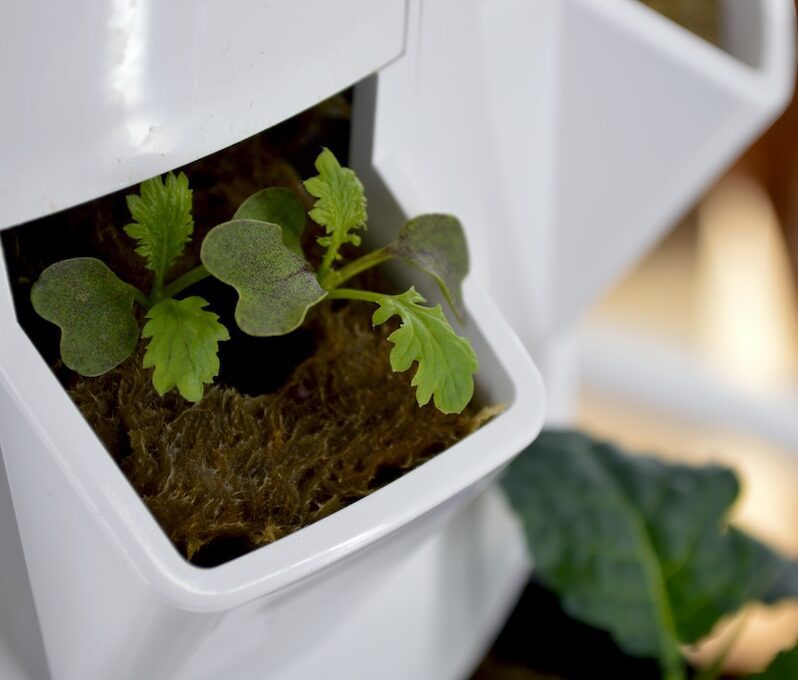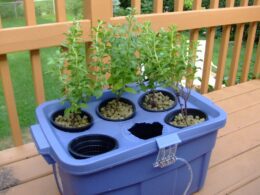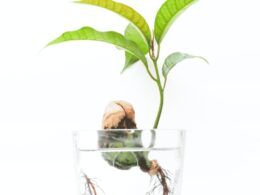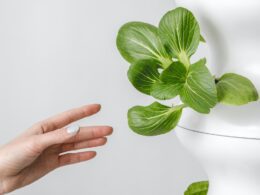Are you interested in hydroponic gardening but worried about how difficult it might be? Don’t worry, hydroponic gardening is not as hard as you might think! With the right knowledge and equipment, you can grow healthy plants without soil in the comfort of your own home.
Hydroponic gardening is a method of growing plants in water with added nutrients instead of soil. It’s an excellent way to grow fresh produce year-round, especially if you don’t have access to outdoor space or if you want to avoid the use of pesticides and herbicides.
While it may seem intimidating at first, hydroponic gardening is actually quite simple once you understand the basics. In this article, we’ll guide you through the essential steps of hydroponic gardening, including selecting the right plants, setting up your system, and maintaining it for optimal growth.
By the end of this article, you’ll be ready to start your own hydroponic garden and enjoy the benefits of fresh, nutritious produce at home.
Understanding the Basics of Hydroponic Gardening
Get ready to explore the fundamentals of growing plants without soil and discover how simple hydroponic gardening can be!
First, let’s talk about the benefits of hydroponic gardening. Hydroponics is a method of growing plants in water and nutrient solutions rather than soil. This technique has several advantages over traditional gardening methods. Hydroponic plants grow faster, use less water, and require fewer pesticides. Additionally, hydroponic gardening allows you to grow crops all year round, regardless of weather conditions.
However, there are common challenges faced by beginners when starting hydroponic gardening. One of the biggest hurdles is maintaining the pH balance of the water. Hydroponic plants are sensitive to the pH level of the water, and if it’s too high or too low, the plants will not grow properly.
Another challenge is ensuring that the nutrient solution is properly mixed and oxygenated. If the solution is not mixed or oxygenated, the plants will not receive the nutrients they need to thrive.
Despite these challenges, hydroponic gardening is not as hard as it may seem. With the right knowledge and tools, you can easily overcome these obstacles and enjoy the benefits of this method.
Plus, there are various resources available, such as online communities and local hydroponic stores, where you can seek advice and guidance. So, don’t be intimidated by the idea of hydroponic gardening. With a little effort and patience, you can successfully grow healthy plants without soil and enjoy the many benefits of this technique.
Selecting the Right Plants for Hydroponic Gardening
You can easily choose the perfect plants for your indoor hydroponic setup with these tips. First, it’s best to start with plants that are easy to grow, such as herbs like basil, parsley, and mint. These plants have short growing cycles and are relatively low-maintenance. Additionally, they are great for beginners because they can tolerate a range of growing conditions.
If you’re looking for more variety, consider vegetables like lettuce, spinach, and tomatoes. These plants are also relatively easy to grow and can thrive in hydroponic systems. However, keep in mind that they require more care and attention than herbs. For example, lettuce needs plenty of light and a consistent temperature to grow properly.
To ensure the best growth for your plants, there are a few tips to keep in mind. First, make sure to choose plants that are well-suited for your indoor environment. This includes considering factors such as light, temperature, and humidity. Additionally, it’s important to provide your plants with the right nutrients and pH levels to support healthy growth.
With these tips in mind, you can enjoy a thriving hydroponic garden in no time.
Setting Up Your Hydroponic System
When setting up your hydroponic system, the first step is to choose the right location. You’ll need a space that’s well-lit, temperature-controlled, and has access to water and electricity.
Next, you’ll need to gather the necessary equipment. This includes grow trays, pumps, and timers.
Finally, you’ll need to prepare the nutrient solution that will feed your plants and ensure they grow to their fullest potential.
Choosing the Right Location
Picking the perfect spot for your hydroponic setup can be crucial to ensuring optimal growth and yield. When choosing the right location, you need to consider whether you want to set up your hydroponic system indoors or outdoors.
If you’re planning to grow plants indoors, make sure you choose a spot with plenty of natural light or invest in grow lights. If you’re going for an outdoor setup, consider the amount of shade that your plants will receive and make sure they get enough sunlight for optimal growth.
Another factor to consider is whether you want to use a vertical gardening setup or a traditional one. If you have limited space, a vertical garden can be a great option as it maximizes the use of vertical space. However, make sure the location you choose can support the weight of the system.
On the other hand, if you have ample space, a traditional setup may be more suitable. Ultimately, choosing the right location for your hydroponic system can make a big difference in the success of your gardening endeavor.
Equipment Needed
To get started with hydroponic gardening, all you’ll need is some basic equipment for your setup. Here are the three essential pieces of equipment you’ll need:
- A hydroponic system – There are several types of hydroponic systems to choose from, such as deep water culture, nutrient film technique, and drip irrigation. Each system has its own advantages and disadvantages, so it’s important to do your research before choosing the one that’s right for you.
- Grow lights – Since hydroponic gardening is done indoors, you’ll need to provide your plants with the proper amount of light. Grow lights come in different types and wattages, so again, it’s important to choose the right one for your particular setup.
- Nutrients – Unlike traditional gardening, hydroponic gardening requires specific nutrients to be added to the water in order to provide the plants with the necessary nutrients for growth. There are many different types of hydroponic nutrients available, so be sure to choose the ones that are appropriate for your plants.
The cost of the equipment needed for hydroponic gardening can vary depending on the type of system you choose and the quality of the equipment. However, with a little research and planning, you can set up a basic hydroponic garden for a reasonable price.
Remember, the initial investment will likely pay off in the long run with a higher yield and less maintenance than traditional gardening.
Preparing the Nutrient Solution
Now it’s time for you to mix the nutrients into the water, creating a nutrient solution that will feed your plants and help them grow strong and healthy, like a chef creating a delicious recipe. Don’t worry, it’s not as complicated as it may seem. All you need to do is follow the nutrient ratios recommended by the manufacturer, which are usually listed on the label of the nutrient bottles.
To make things even easier, here’s a table that shows the recommended nutrient ratios for some common hydroponic crops:
| Crop | Nitrogen (N) | Phosphorus (P) | Potassium (K) | Calcium (Ca) | Magnesium (Mg) |
|---|---|---|---|---|---|
| Lettuce | 14 | 1.6 | 28 | 6 | 2.4 |
| Tomatoes | 20 | 4 | 38 | 11 | 4 |
| Cucumbers | 15 | 5 | 30 | 6 | 3 |
| Strawberries | 12 | 4 | 32 | 6 | 3 |
| Peppers | 15 | 4 | 30 | 6 | 3 |
If you notice any issues with your plants, such as yellowing leaves or stunted growth, it could be a sign of nutrient deficiency or excess. Don’t panic, though – troubleshooting is a normal part of hydroponic gardening. Check the pH of your nutrient solution and adjust it if necessary, as well as checking the nutrient solution’s concentration. Remember that plants have different nutrient requirements at different stages of growth, so make sure to adjust your nutrient solution accordingly. With a little bit of practice and patience, you’ll soon become a pro at creating the perfect nutrient solution for your hydroponic garden.
Maintaining Your Hydroponic System
Now that you’ve set up your hydroponic system, it’s important to maintain it properly. This means monitoring the pH levels of your nutrient solution regularly to ensure optimal plant growth.
You’ll also need to control the temperature and humidity in your grow space to create the ideal environment for your plants. Finally, preventing pests and diseases is crucial to keep your plants healthy and thriving.
Don’t worry, with a little bit of effort, maintaining your hydroponic system is easy and rewarding.
Monitoring pH Levels
Keeping track of the pH levels in your hydroponic system is crucial for the health and growth of your plants. It can take some effort to maintain the ideal balance, but it’s worth it. You need to make sure that the pH level is within a specific range, usually between 5.5 and 6.5.
To ensure measuring accuracy, you need to use a pH meter or pH test strips. These tools will give you an accurate reading of the pH level in your hydroponic system. Once you have measured the pH level, you need to adjust it if it is not in the ideal range. You can use pH up or pH down solutions to adjust the pH level.
Monitoring pH levels may seem like a daunting task, but it is essential for the success of your hydroponic garden. If the pH level is too high or too low, your plants will not be able to absorb the nutrients they need to grow. As a result, your plants may become stunted, discolored, or even die.
It’s important to note that the pH level can change quickly in a hydroponic system, so you need to monitor it regularly. By keeping a close eye on the pH level and adjusting it as needed, you can ensure that your plants are getting the nutrients they need to thrive.
Controlling Temperature and Humidity
Maintaining the perfect temperature and humidity levels is crucial for healthy plant growth in your hydroponic system. To achieve optimal conditions, it’s important to invest in a reliable thermometer and hygrometer to monitor the temperature and humidity levels.
The ideal temperature range for most hydroponic plants is between 65-80°F (18-27°C) during the day and 60-70°F (15-21°C) at night. Humidity levels should be kept between 50-70% for best results.
If you notice that your temperature or humidity levels are not within the optimal range, there are troubleshooting techniques you can use to correct the issue. For temperature control, you can use fans or heaters to regulate the temperature in your grow room. To adjust humidity levels, you can use a dehumidifier or humidifier depending on if the humidity is too high or too low.
By monitoring and adjusting these factors, you can ensure that your hydroponic plants are growing in the best conditions possible.
Preventing Pests and Diseases
Preventing pests and diseases is essential for ensuring the health and longevity of your hydroponic plants. Here are some natural remedies you can use to keep pests at bay:
- Neem oil is a natural insecticide extracted from the seeds of the neem tree. You can mix it with water and spray it on the plants to kill pests.
- Garlic has natural insecticidal properties and can be used to keep pests away. Crush some garlic cloves, mix with water, let it sit for a few hours, and then strain the mixture. Spray it on your plants to keep pests at bay.
- Ladybugs are natural predators of aphids, mealybugs, and other pests. You can buy ladybugs and release them in your hydroponic garden to keep pests under control.
Chemical solutions are also available for pest control strategies in hydroponics. However, it’s important to use them with caution as they may harm the plants and the environment.
Common diseases in hydroponics include powdery mildew, root rot, and bacterial wilt. To prevent these diseases, make sure to maintain proper hygiene in your hydroponic garden. Clean the equipment regularly, keep the environment dry, and avoid overcrowding the plants.
By following these simple steps, you can ensure the health and safety of your hydroponic garden.
Tips for a Successful Hydroponic Garden
If you’re new to hydroponic gardening, it’s best to start small. This allows you to learn from mistakes without wasting too much time or resources.
Remember to stay consistent and patient, as hydroponic gardening can require some trial and error.
Start Small
You can easily begin with a small hydroponic setup to gain experience and confidence before expanding. Choosing the right container and finding suitable lighting are important factors to consider when starting small.
You can use a variety of containers, such as buckets or plastic storage bins, as long as they’re clean and have drainage holes. For lighting, LED grow lights are a popular option as they’re energy-efficient and provide the necessary light spectrum for plant growth.
Starting small also allows you to focus on one or two plants, making it easier to monitor their growth and adjust the nutrient levels accordingly. As you gain more experience, you can gradually add more plants and expand your setup.
Remember to keep track of your progress and make notes on what works and what doesn’t. With patience and persistence, you can achieve a successful hydroponic garden, even if you start small.
Learn from Mistakes
Don’t beat yourself up over mistakes, we all make them. When starting out in hydroponic gardening, it’s important to remember that failures and challenges are inevitable. However, the key to becoming a successful hydroponic gardener is learning from those mistakes and using those lessons to improve and grow.
One way to learn from failures is to keep a journal and record what you did and how your plants responded. This will help you identify patterns and make adjustments accordingly. Additionally, adapting to different plant species is an important aspect of hydroponic gardening. Each plant has unique needs, and it’s important to research and understand those needs before planting.
By doing so, you’ll be better equipped to overcome any challenges that may arise. Remember, like any skill, hydroponic gardening takes practice and patience, but by learning from your mistakes and adapting as necessary, you can become a successful hydroponic gardener.
Stay Consistent and Patient
Stay patient and consistent in your efforts to nurture your plants, and over time, you’ll see the fruits of your labor pay off as you watch your greenery flourish.
Hydroponic gardening can be a bit daunting at first, but don’t let that discourage you. To be successful, you need to have a consistent routine and patience to see your plants grow.
Consistency tips include monitoring your plants’ growth regularly, keeping a consistent nutrient schedule, and ensuring that your environment stays stable. You can also practice patience strategies like taking time to research and learn about hydroponic gardening, starting with easy-to-grow plants, and not getting discouraged by setbacks.
Remember, the key is to keep going, stay consistent and patient, and you’ll eventually get the hang of it.
Frequently Asked Questions
How much does it cost to set up a hydroponic garden?
If you’re considering setting up a hydroponic garden, budget considerations are likely at the forefront of your mind. Fortunately, there are DIY options available that can help keep costs down. Depending on the size and complexity of your setup, you can expect to spend anywhere from a few hundred to a few thousand dollars on materials and equipment.
One of the benefits of hydroponic gardening is that it can be done indoors, which means you can bypass the costs associated with traditional outdoor gardening, such as soil and pesticides. With a little research and creativity, you can set up a budget-friendly hydroponic garden that will yield impressive results.
Can hydroponic gardening be done outdoors?
Yes, hydroponic gardening can be done outdoors, but there are some limitations to consider.
One of the biggest challenges is the environmental impact of outdoor hydroponic gardening. You need to make sure that your plants are receiving enough sunlight, water, and nutrients, while also protecting them from pests and extreme weather conditions.
However, there are also many environmental benefits to outdoor hydroponic gardening. By growing your own plants, you can reduce your carbon footprint and enjoy fresh, organic produce right in your backyard.
While there may be some challenges involved, outdoor hydroponic gardening is a great way to connect with nature and promote sustainable living.
Are there any disadvantages to using hydroponics instead of traditional soil-based gardening?
When it comes to hydroponic gardening, there are a few disadvantages to consider. One of the biggest disadvantages is the cost. Setting up a hydroponic system can be quite expensive, especially when compared to traditional soil-based gardening.
Additionally, hydroponics requires a lot of energy to maintain the right temperature, humidity, and lighting. Another disadvantage is the complexity of the system. If you’re new to gardening or don’t have experience with hydroponics, it can be challenging to set up and maintain.
However, if you’re looking for soil-based alternatives, there are plenty of options available, including raised beds, container gardening, and traditional garden plots. Ultimately, the choice between hydroponics and soil-based gardening will depend on your personal preferences, budget, and experience level.
Do hydroponic plants require a different type of fertilizer than traditional plants?
When it comes to hydroponic farming, the types of nutrients required for plants differ from traditional soil-based gardening. Hydroponic plants need a specialized nutrient solution that provides everything they need to grow, including nitrogen, phosphorus, and potassium.
The benefits of hydroponic farming are numerous, including faster growth rates, higher yields, and reduced water usage. In fact, hydroponic plants can grow up to 50% faster than those grown in soil.
So, while there may be some differences in the type of fertilizer required for hydroponic plants, the benefits of this method make it well worth the effort. Plus, with the right equipment and guidance, hydroponic gardening can be an easy and rewarding experience.
How long does it take for hydroponic plants to reach maturity compared to traditional plants?
Hydroponic growth rates are impressive when compared to traditional plants. The benefits of nutrient absorption speed and efficiency in hydroponic systems lead to faster growth rates and earlier maturity.
Hydroponic plants can mature up to 25% faster than traditional plants, making it an ideal method for commercial growers. Also, hydroponic plants have a higher yield, use less water, and fewer nutrients than traditional plants.
With faster growth rates and increased efficiency, hydroponic gardening provides a more sustainable and cost-effective way to grow plants.
Conclusion
Congratulations on taking the first step towards hydroponic gardening! Now you understand the basics of hydroponics, have selected the right plants, and set up your hydroponic system.
But the real work begins now. Maintaining your system and ensuring your plants thrive requires regular attention. Remember to check your nutrient levels, pH balance, and water temperature. Keep a close eye on your plants for any pests or diseases. Adjust lighting and watering schedules as needed.
With patience and dedication, your hydroponic garden will flourish, providing you with fresh, healthy produce year-round. Keep these tips in mind and enjoy the benefits of your hard work!









